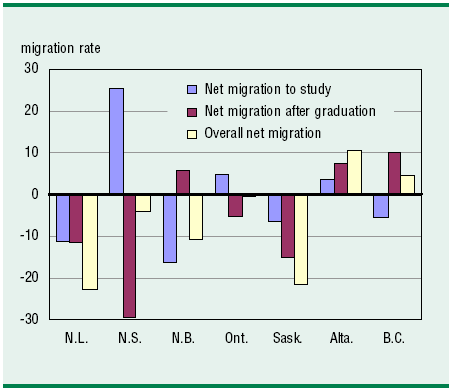Publications
Health Human Resources and Education in Canada
Where Do Canadian Health University Graduates Move after Graduation
Where Do Canadian Health University Graduates Move after Graduation?
Archived Content
Information identified as archived is provided for reference, research or recordkeeping purposes. It is not subject to the Government of Canada Web Standards and has not been altered or updated since it was archived. Please "contact us" to request a format other than those available.

Geographical mobility of health graduates is an important aspect of health-care planning and management. Data from Statistics Canada's National Graduates Survey, Class of 2005, show that 14% of health graduates and 11% of health-related graduates moved to a different province in the two years following graduation. These rates are higher than the average for all other university programs (10%).
Mobility was highest among graduates in medicine (25%), communication disorders (19%), rehabilitation (19%) and pharmacy (17%) and lowest among graduates in nursing (10%), psychology and social work (with 11% respectively).
Much of this movement reflects the fact that not all health-education programs are offered in every province. As a result, students in some provinces have to move in order to study in the program of their choice. Many likely return to their home province following graduation.
A snapshot of provincial migration
Newfoundland and Labrador and Saskatchewan experienced both net out-migration to study and net out-migration of health graduates in the two years following graduation (Chart 1).1
New Brunswick and British Columbia experienced net out-migration of students to study, but net in-migration of graduates. The reverse was the case for Nova Scotia and Ontario.
Alberta was the only province with net inflows of both students and graduates.
Chart 1
Net migration rates of health graduates, Class of 2005

Source: Statistics Canada. National Graduates Survey (Class of 2005).
Overall, Alberta and British Columbia were the only two provinces showing net gains. The number of university health graduates residing in these two provinces in 2007 was significantly higher than the number of students living there before beginning their programs of study (2,000 vs. 1,800 for Alberta and 2,100 vs. 2,000 for British Columbia).
All other provinces experienced net out-migration, ranging from slightly less than 1% in Ontario to about 22% in Newfoundland and Labrador and Saskatchewan.
What factors play a role in mobility?
Overall, then, about one in ten health graduates from the Class of 2005 had migrated out of their home province to study and a slightly higher proportion moved to a different province in the two years following graduation.
Although much of this movement reflects the fact that not all health-education programs are offered in every province, further research is needed to fully understand the reasons behind mobility of health students and graduates.
Note
- Sample size constraints limit the provision of detailed information on net in-flows and out-flows of graduates from health and health-related fields of study for Prince Edward Island and Manitoba. In the case of Quebec, in- and out-migratory flows are too small to be reported.
- Date modified:
